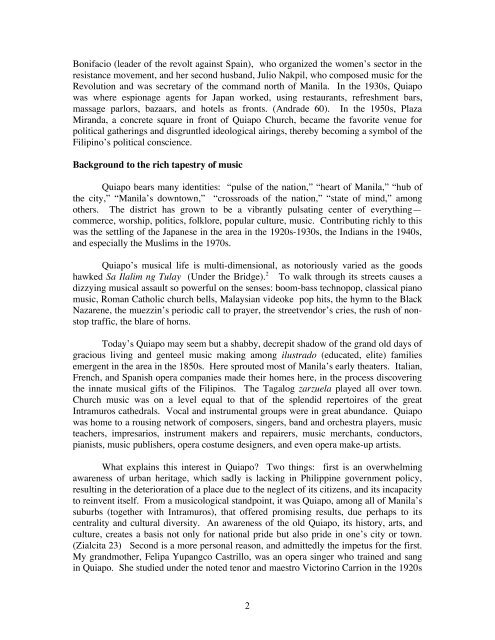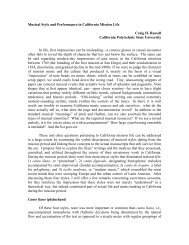Music in The Heart of Manila - Center for Iberian and Latin American ...
Music in The Heart of Manila - Center for Iberian and Latin American ...
Music in The Heart of Manila - Center for Iberian and Latin American ...
Create successful ePaper yourself
Turn your PDF publications into a flip-book with our unique Google optimized e-Paper software.
Bonifacio (leader <strong>of</strong> the revolt aga<strong>in</strong>st Spa<strong>in</strong>), who organized the women’s sector <strong>in</strong> the<br />
resistance movement, <strong>and</strong> her second husb<strong>and</strong>, Julio Nakpil, who composed music <strong>for</strong> the<br />
Revolution <strong>and</strong> was secretary <strong>of</strong> the comm<strong>and</strong> north <strong>of</strong> <strong>Manila</strong>. In the 1930s, Quiapo<br />
was where espionage agents <strong>for</strong> Japan worked, us<strong>in</strong>g restaurants, refreshment bars,<br />
massage parlors, bazaars, <strong>and</strong> hotels as fronts. (Andrade 60). In the 1950s, Plaza<br />
Mir<strong>and</strong>a, a concrete square <strong>in</strong> front <strong>of</strong> Quiapo Church, became the favorite venue <strong>for</strong><br />
political gather<strong>in</strong>gs <strong>and</strong> disgruntled ideological air<strong>in</strong>gs, thereby becom<strong>in</strong>g a symbol <strong>of</strong> the<br />
Filip<strong>in</strong>o’s political conscience.<br />
Background to the rich tapestry <strong>of</strong> music<br />
Quiapo bears many identities: “pulse <strong>of</strong> the nation,” “heart <strong>of</strong> <strong>Manila</strong>,” “hub <strong>of</strong><br />
the city,” “<strong>Manila</strong>’s downtown,” “crossroads <strong>of</strong> the nation,” “state <strong>of</strong> m<strong>in</strong>d,” among<br />
others. <strong>The</strong> district has grown to be a vibrantly pulsat<strong>in</strong>g center <strong>of</strong> everyth<strong>in</strong>g—<br />
commerce, worship, politics, folklore, popular culture, music. Contribut<strong>in</strong>g richly to this<br />
was the settl<strong>in</strong>g <strong>of</strong> the Japanese <strong>in</strong> the area <strong>in</strong> the 1920s-1930s, the Indians <strong>in</strong> the 1940s,<br />
<strong>and</strong> especially the Muslims <strong>in</strong> the 1970s.<br />
Quiapo’s musical life is multi-dimensional, as notoriously varied as the goods<br />
hawked Sa Ilalim ng Tulay (Under the Bridge). 2 To walk through its streets causes a<br />
dizzy<strong>in</strong>g musical assault so powerful on the senses: boom-bass technopop, classical piano<br />
music, Roman Catholic church bells, Malaysian videoke pop hits, the hymn to the Black<br />
Nazarene, the muezz<strong>in</strong>’s periodic call to prayer, the streetvendor’s cries, the rush <strong>of</strong> nonstop<br />
traffic, the blare <strong>of</strong> horns.<br />
Today’s Quiapo may seem but a shabby, decrepit shadow <strong>of</strong> the gr<strong>and</strong> old days <strong>of</strong><br />
gracious liv<strong>in</strong>g <strong>and</strong> genteel music mak<strong>in</strong>g among ilustrado (educated, elite) families<br />
emergent <strong>in</strong> the area <strong>in</strong> the 1850s. Here sprouted most <strong>of</strong> <strong>Manila</strong>’s early theaters. Italian,<br />
French, <strong>and</strong> Spanish opera companies made their homes here, <strong>in</strong> the process discover<strong>in</strong>g<br />
the <strong>in</strong>nate musical gifts <strong>of</strong> the Filip<strong>in</strong>os. <strong>The</strong> Tagalog zarzuela played all over town.<br />
Church music was on a level equal to that <strong>of</strong> the splendid repertoires <strong>of</strong> the great<br />
Intramuros cathedrals. Vocal <strong>and</strong> <strong>in</strong>strumental groups were <strong>in</strong> great abundance. Quiapo<br />
was home to a rous<strong>in</strong>g network <strong>of</strong> composers, s<strong>in</strong>gers, b<strong>and</strong> <strong>and</strong> orchestra players, music<br />
teachers, impresarios, <strong>in</strong>strument makers <strong>and</strong> repairers, music merchants, conductors,<br />
pianists, music publishers, opera costume designers, <strong>and</strong> even opera make-up artists.<br />
What expla<strong>in</strong>s this <strong>in</strong>terest <strong>in</strong> Quiapo? Two th<strong>in</strong>gs: first is an overwhelm<strong>in</strong>g<br />
awareness <strong>of</strong> urban heritage, which sadly is lack<strong>in</strong>g <strong>in</strong> Philipp<strong>in</strong>e government policy,<br />
result<strong>in</strong>g <strong>in</strong> the deterioration <strong>of</strong> a place due to the neglect <strong>of</strong> its citizens, <strong>and</strong> its <strong>in</strong>capacity<br />
to re<strong>in</strong>vent itself. From a musicological st<strong>and</strong>po<strong>in</strong>t, it was Quiapo, among all <strong>of</strong> <strong>Manila</strong>’s<br />
suburbs (together with Intramuros), that <strong>of</strong>fered promis<strong>in</strong>g results, due perhaps to its<br />
centrality <strong>and</strong> cultural diversity. An awareness <strong>of</strong> the old Quiapo, its history, arts, <strong>and</strong><br />
culture, creates a basis not only <strong>for</strong> national pride but also pride <strong>in</strong> one’s city or town.<br />
(Zialcita 23) Second is a more personal reason, <strong>and</strong> admittedly the impetus <strong>for</strong> the first.<br />
My gr<strong>and</strong>mother, Felipa Yupangco Castrillo, was an opera s<strong>in</strong>ger who tra<strong>in</strong>ed <strong>and</strong> sang<br />
<strong>in</strong> Quiapo. She studied under the noted tenor <strong>and</strong> maestro Victor<strong>in</strong>o Carrion <strong>in</strong> the 1920s<br />
2




